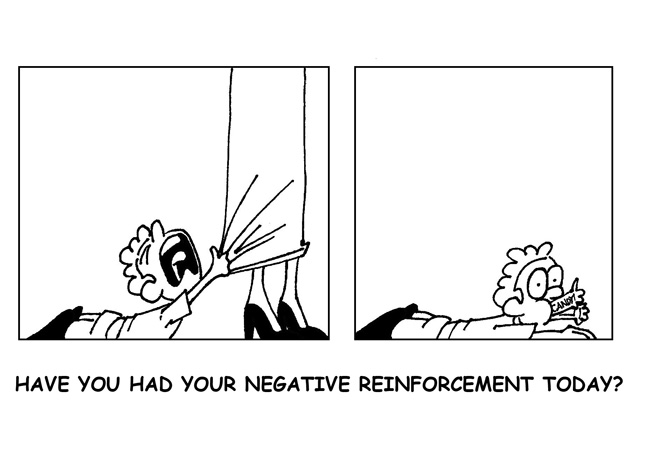Lesson 5: Negative Reinforcement
Attention

Learning Outcomes
Upon completion of this lesson's material, students will be able to:
- Contras Positive Reinforcement and Negative Reinforcement
- Identify examples of Negative Reinforcement Loop
Teaching
Negative Reinforcement
First...NEGATIVE REINFORCEMENT is NOT PUNISHMENT
In this course, and in all of Psychology, the definition of terms as as vital as the concepts they represent!
We have learned that a Reinforcement either INCREASES or MAINTAINS behavior...a Negative Reinforcement is STILL a Reinforcement and it still INCREASES or MAINTAINS behavior...it just does it by a different method. Essentially here it is...
Negative Reinforcement operates when the removal of a negative stimlus is reinforcing.
Here are some examples:
- The annoying buzzer in your car STOPS when you put your seatbelt on
- Your annoying kid STOPS when you buy him that candy bar
- Your nagging (wife/husband/mother-in-law) STOPS nagging when you take out the trash (hopefully)
- Your lecturing by your mother STOPS when you get your homework done
- "You will get your toy back when you stop yelling"
- "You will get out of prison when you are a model prisoner for 1 year"
- A student gets sent to the office in math class when he acts out in class (more on this one in a bit!)
The "Negative Reinforcer" is the "annoying thing" that goes away when you engage in the target behavior. The important point to remember is that this is STILL a REINFORCER so behavior is still INCREASING and being MAINTAINED
Here is another way to think about it... In Abnormal Psychology, Mental Illness has both "Positive" symptoms and "Negative" symptoms. What we mean by this is that some symptoms ADD something (such as delusions in a person with schizophrenia) and that some symptoms TAKE AWAY something (such as decreased motivation in a person with depression). Use THESE definitions of "Positive" and "Negative" when relating to Postive and Negative Reinforcement... BOTH increase or maintain behavior ONE (Postiive) does it by ADDING something...such as a reward... ONE (Negative) does it by TAKING SOMETHING AWAY...such as a buzzer, or nagging, or acting out Some confusion can also happen when we think of WHO is being reinforced...so here is an example... A child wants some ice cream and starts to whine. The parent says to the child..."If you go clean your room I will let you have an ice cream." The child goes to clean the room and gets an ice cream. The ice cream is the positive reinforcer for the "cleaning room" behavior. Another child wants some ice cream and starts to whine. The parent ignores her for a bit but then cannot stand anymore and gives the child an ice cream...now, read carefully...
|
Negative Reinforcement Loop
There is a bad side to this...and it happens in schools all the time. For this example, keep the ABC model in mind as I describe the following scenario.
A teacher, Miss Cynthia, is stuck teaching a mixed ability class the complexities of Algebra. In this particular class she is going over the FOIL method of simplifying equations. (First-Outer-Inner-Last, for you mathophobes!) Rabecca (a student) hates math...she has also not done any homework! We have here, the Behavioral Perfect Storm! Rebecca begins to act out. For her this is "continual talking with her friends" (which has been a problem before). Miss Cynthia asks her to quiet down and pay attention and Rebecca says, "Yeah, whatever...!" (You know the tone!) Miss Cynthia has had it with Rebecca's attitude and tells her to report to the Vice-Principal's office and that she is to serve detention. ....Here is the Behavioral Perfect Storm To Rebecca, Math Class is the negative stimulus that she wants to get away from...so she "acts out" and she is rewarded when the negative stimulus is taken away. To Miss Cynthia, Rebecca is the negative stimulus that she wants to get away from...so she "acts out" (sending her to the office instead of dealing with the behavior in the classroom) and she is rewarded when the negative stimulus is taken away. This is a Win-Win situation for both Rebecca and Miss Cynthia, on behavioral terms! Except it really is a Lose-Lose, isn't it? Now, think about the times that a parent gives in to the (unreasonable) demands of their kids , or when you concede an arguement where it is clear that you are right...there are lots of "Perfect Storms" out there! |
Assessment
Lesson 5 Quiz
- In clear precise terms differentiate between Positive Reinforcement and Negative Reinforcement. It should be clear to me that you understand how they are the same and how they are different.